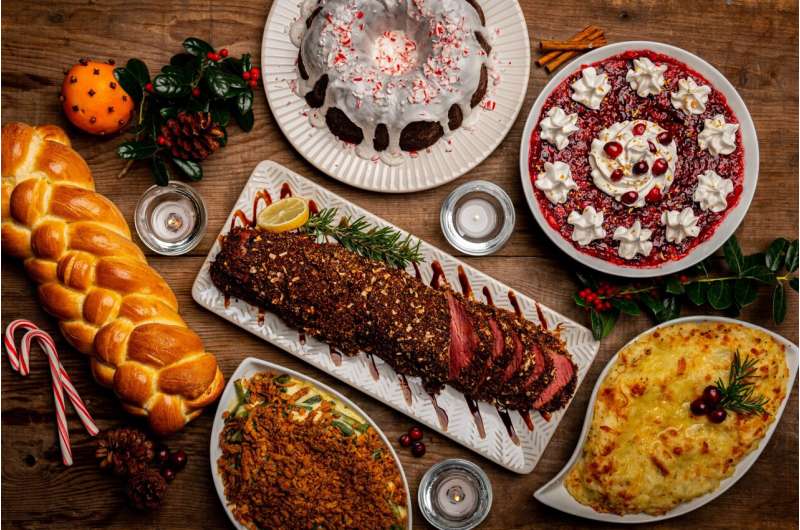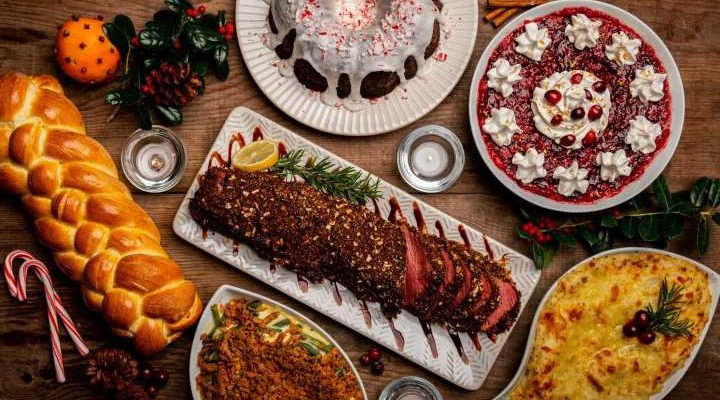
It’s that time of the year. Tables get decorated, fridges get loaded and we gather in the spirit of the most wonderful season of all. From salads to desserts, Christmas is a time of variety in foods, and a heaven for our senses. But nothing can spoil the fun as much as a sick stomach in the aftermath of a cheerful celebration.
Recent data shows the annual cost of foodborne illness in Australia is a whopping $2.44 billion. Nearly 5 million of us suffer from foodborne gastroenteritis each year and nearly 50,000 of us end up in hospital.
So, let’s prepare for the big day with some helpful tips for keeping common Christmas foods safe to eat.
Seafood platter
Prawns, salmon, Moreton Bay bugs or sashimi as an entrée to your Christmas meal—what a treat! However, mixing raw, cooked, and smoked products in a seafood platter requires careful attention.
Raw seafood like sashimi can pose a parasite risk. Marinades do not help reduce food safety risk in raw fish. Sashimi made from wild caught fish is more likely to contain parasites than farmed fish and should always be treated as contaminated.
If you’re making sashimi at home, you’ll need to freeze the fish for 24 hours to a week at -20°C to kill these unwanted Christmas parasites. All seafood, regardless of how it’s prepared, is also sensitive to the bacterium Listeria.
There are two key food safety rules that are extra important to follow when preparing seafood because of its potential risks. First, always wash your hands and surfaces before and after preparing seafood.
Second, always follow the 2/4 hour rule. This rule says you can serve food if it’s been sitting at room temperature for two hours or less. It can then go back into the fridge, but the clock starts again with any additional time out of the fridge. Once food gets to a total of 4 hours sitting at room temperature, it must be thrown out.
Oysters
Raw oysters can be a source of harmful bacteria, Vibrio vulnificus, which can cause a life-threatening illness. People with underlying health conditions such as a weakened immune system, liver disease or diabetes are particularly sensitive to this bacterium. Adding hot tabasco sauce, hot chili sauce, lemon juice or alcohol to oysters might get rid of some germs. But none of these are sufficient to kill Vibrio.
The only safe way to consume oysters is to make sure they are cooked thoroughly. If you still want raw oysters, make sure you buy them from a reputable producer or restaurant that follows strict hygiene measures.
Roast turkey
If you’ve decided to include roast turkey in your Christmas lunch or dinner, make sure you cook the meat thoroughly.
The center of the meat should reach 74°C to ensure you kill pathogens such as Salmonella and Campylobacter. It’s worth investing in a meat thermometer so you know when it’s done, as color isn’t always a good indicator.
Soft cheeses
Soft cheeses such as brie, camembert, ricotta, feta, mozzarella and blue cheeses pose a risk of a bacteria known as Listeria monocytogenes. This is particularly dangerous for vulnerable populations, including people who are pregnant, elderly or immunocompromised. These people are recommended to avoid soft cheese altogether.
For the rest of the population, the safest way to avoid Listeria infection is to follow the 2/4 hour rule. If soft cheeses are served outdoors, make sure to keep them cool by taking an esky and ice blocks.
Christmas salads
Refreshing salads with raw vegetables are a festive staple. Although usually healthy, they do require some special handling to keep them that way. The Grinches in this scenario? Listeria, E. coli, Salmonella, Hepatitis A, Norovirus, Cyclospora and many more.
To keep these unwelcome guests away from your salad, use separate cutting boards for raw meats and produce. Transport salads in a cool Esky or store in the refrigerator. Wash your hands frequently rather than wearing gloves, as they can cross-contaminate foods.
BBQs
Aussies love throwing anything on the barbie and Christmas Day is no exception. There are two main risk factors for food poisoning when cooking on a barbecue: undercooked meat and spreading germs from raw meat onto food that’s cooked or ready to eat.
Cook beef, veal, lamb and pork to at least 63°C and rest for three minutes before eating. Cook minced meat to 71°C, and chicken and turkey to 74°C.
To avoid cross-contamination, don’t use the same knife, tongs or other utensils on raw meat as cooked meats or other ingredients.
Pavlova, trifle and cake
The dessert holy trinity of pavlova, trifle and cake! Topped with cream, they’re delicious but vulnerable to bacteria such as E. coli, Salmonella and Listeria from contaminated utensils or hands.
Always wash your hands before handling ingredients like fruit and use clean tools when whipping cream. Stick to the 2/4 hour rule once the cream comes out of the fridge or Esky.
Pavlova bases call for raw eggs, which introduces a risk of contamination from Salmonella. When baking the meringue, make sure the core reaches 74°C or higher.
Christmas pudding
Luckily, the main ingredients of Christmas pudding—fruit, nuts, liquor and sugar—are good at inhibiting bacterial growth.
However, Christmas pudding can become riskier if you add a “lucky coin.” A study by the Nature British Dental Journal in 2016 showed using coins in Christmas pudding presents a physical risk to teeth and a choking hazard. If you really want to add a coin, 50 cent coins are the best as their size is a threshold for choking hazard. But always warn each and every guest, or that coin mightn’t be so lucky after all.
Eggnog
Eggnog is traditionally made with raw eggs, milk, sugar, heavy cream and vanilla extract. It’s often sprinkled with brandy and decorated with grated nutmeg and cinnamon sticks. Although delicious, raw egg can introduce Salmonella.
The safest way to prepare eggnog is by using pasteurized egg or a cooked egg base. There are plenty of cooked egg eggnog recipes online.
Will the rum or whisky kill the Salmonella in the raw eggs? No. Will adding the eggnog to hot coffee kill Salmonella? Again, no.
Adding cold creamy eggnog to a hot coffee will quickly decrease the temperature, rendering it too cool to kill the Salmonella. The internal temperature of the eggnog coffee mixture must be at least 71.11 °C for it to be safe.
Keeping this knowledge in mind, you’ll be sure to have a merry little food-safe Christmas.
Source: Read Full Article
